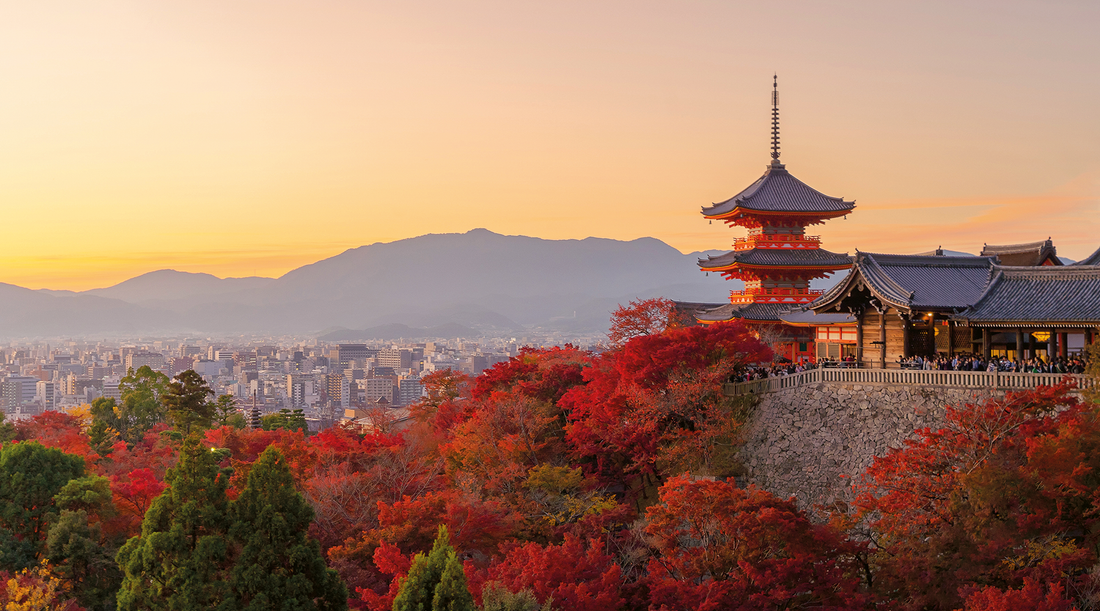
Kyoto - The ancient essence of an authentic Japan
Share
Kyoto, the country's ancient capital, is located in the Kansai region of south-central Japan. Founded in the eighth century under the name Heiankyo, meaning "capital of peace and tranquility," Kyoto was urbanized on a plain at the foot of the mountains, laid out in regular squares, following the rules of feng shui. Filled with Shinto and Buddhist atmospheres, Kyoto is a Zen city that invites us to immerse ourselves in traditional Japan and absorb its rich natural beauty.

Many of the key characteristics of Japanese culture originate in Kyoto and are deeply rooted in the lives of its residents to this day. It's no wonder that most of them call the city home. Respect for ancestral culture, the wisdom of elders, and local values—harmonious characteristics of Buddhist culture—is felt in every corner and should be considered by visitors. Local communities value good manners, which also helps preserve Kyoto's culture and make tourism sustainable. Because they already share their community and its surroundings with tourists, residents appreciate respect for their spaces and properties, especially the houseboats, small temples where peace and quiet reign.

As much as there is to see, there is even more to experience. Kyoto offers, on the one hand, immersion in slow living, in the ancestral, in the silence of contact with nature that touches the materially built, translating into a single contemplative space. On the other, a modernity that marks the pulse of modern life. Rich in its cultural heritage, it offers visitors a unique experience.
«Kyoto is a Zen city, which invites us to immerse ourselves in traditional Japan and absorb its rich natural beauty.»
Simplicity, material detachment, the search for inner peace, and the symbolism of the gods are present in the city's most ancient characteristics. The tradition of "machiya," for example, traditional wooden houses, is one of Kyoto's most beautiful images. Endangered, some of them considered Japanese heritage, they functioned simultaneously as residences and workplaces, and today are often used for tea ceremonies.
Surrounded by mountains and rich in vegetation, Kyoto offers, in certain places, an unexpected atmosphere of a peaceful rural village. The famous Arashiyama bamboo grove offers a refreshing oasis of nature along the Hozu River. Its beauty transcends the visuals: even the sounds are unique. The Ministry of the Environment has included the site as one of the country's official soundscapes. And while touring the region, passing by Saiho-ji Temple is a marvel at the serenity and deep integration of the place with nature. Another highlight are the lagoons near Osawa and Hirosawa, which dazzle with their picturesque and multi-sensory beauty.
Also not to be missed is Nijo Castle, covered in intricate wood carvings and extravagantly painted panels, and Kyoto Palace, the majestic former residence of the Japanese imperial family. Kinkak-ji Temple, also known as the Golden Pavilion, has its Buddhist architecture covered in gold leaf, making it a stunning icon of traditional Japanese architecture and a UNESCO World Heritage Site.
Kyoto's illuminated shrines are also a must-see, as are its historic buildings and unforgettable ancient landscapes. And, in keeping with this connection to the gods, throughout the city, you'll find numerous Jizo statues, made of clay, bronze, or stone, representing the guardian deity of children and travelers.
«Each district of Kyoto offers its own unique charm and attractions, blending the historic with the modern.»
Each district of Kyoto offers its own unique charm and attractions, blending the historic with the modern. The contrast between modern culture and skyscrapers versus traditional culture and ancient temples makes this a city that blends two worlds. Modern Kyoto boasts refined elegance and contemporary cultural immersion, with modern structures and technologies that represent a new interpretation of traditional forms, where echoes of ancient heritage meet the pulse of contemporary luxury. Some of the city's most modern architectural icons are Kyoto Station and Kyoto Tower, whose observation deck offers one of the most modern views of the city.
Japanese food also doesn't go unnoticed; on the contrary, it brings color and life to the city's daily life. The food is generally healthy and nutritionally balanced. A taste for tea and tastefully arranged flowers in open spaces are an invitation to experience a culture that is a true kaleidoscope. Kyoto combines traditional dishes and gastronomic innovations and can truly transform during some of its more traditional events and festivals, highlighting its rich cultural heritage.

Despite its modernity, true Japanese luxury lies in simplicity, care, and the ancestral nature of serene customs. The Kyoto community, a "temple," reflects the luxury sought today.
«Despite its modernity, true Japanese luxury lies in its simplicity, care, and ancestral serene habits.»
Text: Carla Martins
Photos: All Rights Reserved
